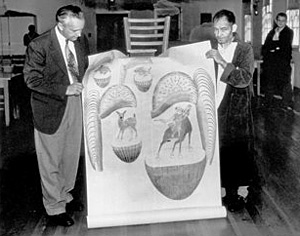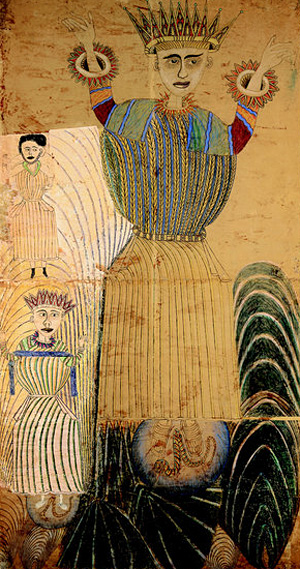 |
 |
 |
 Vallarta Living | Art Talk | May 2007 Vallarta Living | Art Talk | May 2007  
A Troubled Artist's Gift Triumphs
 Susan Ferriss - Bee Staff Writer Susan Ferriss - Bee Staff Writer


| | Martín Ramírez, above right, shows one of his paintings in about 1950 at DeWitt State Hospital in Auburn, where he was a patient. He is assisted by Tarmo Pasto, a Sacramento college professor at the time, who arranged showings of Ramírez's work at Sacramento's Crocker Art Museum and in the Bay Area. (Phyllis Kind Gallery) | 
| | An untitled drawing and collage by Ramírez, who mixed his own colors by grinding crayons and pencils. (Phyllis Kind Gallery) |
Martín Ramírez's wife was filled with dread the day in 1925 when he left Mexico for California and the promise of work on the railroads and in mines.

It was Aug. 24, the feast day of St. Bartholomew, and the hard wind was whistling so fiercely that Ramírez's wife took it as an omen that "the devil was on the loose."

True enough, four years later, misfortune befell Ramírez. The Great Depression hit California, and the migrant worker, then 36, fell deeply into a private hell. Found wandering the streets of Stockton, he was committed to a state hospital.

Diagnosed as schizophrenic, Ramírez ended up institutionalized in 1948 in Auburn's then-DeWitt State Hospital. There he would spend the rest of his days.

He never saw his wife and four children again, never returned to work the Mexican rancho he loved. Instead, Ramírez did what mental patients often did: He created art. And he did so obsessively.

But the art that Ramírez made, without formal training, until his death in 1963 demonstrated such innate skill and vision that many critics today consider him an enigmatic genius.

The work emerged beyond DeWitt's doors starting in the 1950s thanks to Tarmo Pasto, then an art and psychology professor at what is now California State University, Sacramento. Pasto arranged shows at Sacramento's Crocker Art Museum, in Berkeley and at Oakland's Mills College.

Collectors began to prize the work, but Ramírez still was not widely known - until now.

Starting June 9, at the San Jose Museum of Art, the public will have a chance to see the most extensive, richly annotated exhibit ever of Ramírez's work.

Only exhibit on West Coast

In partnership with San Jose's Mexican Heritage Plaza, the three-month Ramírez show is a West Coast exclusive. It will feature most of the same privately and publicly owned pieces displayed at an acclaimed exhibit that closed May 13 at the American Folk Art Museum in New York City.

"We decided that somehow we would have to bring Martín home to California," said Marcela Davison-Aviles, president of the Mexican Heritage Plaza.

Brooke Anderson, curator of the New York show, will lecture on Ramírez at the plaza in July. So, too, will Chicago-based sociologist Victor Espinosa, who spent years locating descendants of Ramírez and people who knew him at DeWitt.

At first forcibly - and later voluntarily - confined, Ramírez produced hundreds of meticulous, nearly mathematically structured renderings of trains on tracks charging toward ominous tunnels, and Mexican-style horsemen game for action but trapped in time and place.

He also drew exquisite medieval-like landscapes and tall, primitive Madonnas. He was obsessed with juxtaposition and fashioned collages combining visions of his Mexico with images of 1950s Americana he clipped out from magazines.

In some pieces, well-coiffed American housewives wear Emiliano Zapata-style bandoliers. In others, sleek American sedans glide past colonial churches.

Ramírez fans believe his work reflects great discipline and originality, while capturing the turmoil and wonder that come with the immigrant experience. Mainstream art world purists see it as "outsider art," a category of work done by impassioned but unschooled artists, many of them in extreme mental states.

Ramírez was a mystery even to his descendants, for whom the surge of acclaim for his art has been especially satisfying.

María de Jesus Reyes Ramírez, a granddaughter, is a U.S. citizen who was raised in Mexico by María Santa Ana, Ramírez's wife.

Mental illness talk taboo

Now 67, Reyes immigrated to the Los Angeles suburbs in 1971. Talk of her grandfather's mental illness, she said, was taboo in Mexico.

"For my mother - I called my grandmother 'mother' - the United States was a place that swallowed people," Reyes said in an interview at her Alhambra home, which is decorated with prints of Ramírez's work.

Growing up, Reyes said, all she knew of her grandfather was that he was confined because of insanity and that he drew a lot.

It was not until Espinosa found Reyes and other descendents that she and her six daughters began to grasp the magnitude of Ramírez's legacy.

The first time Reyes saw an exhibit of her grandfather's work was several years ago when Espinosa suggested she travel to Santa Fe, N.M., for a show.

Emotionally overwhelmed by what she saw, she and her daughters began scouring the Internet for anything about Ramírez.

Elia Diaz, the eldest of Reyes' daughters, was born in the family's hometown of Tepatitlán, in Jalisco state. She sees in her great-grandfather's work the churches and landscapes of her childhood.

One of her favorite pieces is a long, vertical drawing on brown paper, called the "Paper Bag Scroll."

"Do you see the two roads going up each side? One is the campesino (peasant) road, and the other is the modern road with cars on it. They go together, but they don't ever connect," Diaz said.

"That is my great-grandfather on the top, on his horse," Diaz said, pointing at the drawing's upper left corner, where the peasant road ends. The horseman looks across the page at another horseman who traveled up the modern road and stopped outside a building of dark windows that Diaz believes represents DeWitt State Hospital.

Hoping to be rescued?

Another surreal piece that observers often find amusing is, for Reyes, really a cry for help.

The piece is dominated by a magazine cutout of an American woman in a pillbox hat. Ramírez drew antennae on the woman's hat and gave her arms that hold hooks and a rope tied around the waist of a tiny man in a deep well.

"He wants someone, maybe his wife, to come rescue him," Reyes said.

James Durfee, 78, was a psychiatric caregiver at DeWitt who saved Ramírez's pictures for Pasto, the Sacramento professor. He recalls his patient as friendly but mute, although Espinosa tracked down three people to whom Ramírez spoke in Spanish while at DeWitt.

Durfee, who still lives in Auburn, said employees were intrigued by Ramírez's work, but most shrank away from it because the artist used his saliva mixed with mashed potatoes to make a paste for his drawings.

The former caregiver remembers Ramírez pasting together large canvases of paper bags, discarded medical notations and other scraps he retrieved from waste baskets.

"He used to squat under dining tables to draw," Durfee said. "He might have felt safer there."

Tools were improvised

Ramírez also made his own colors, grinding crayons and pencils into bowls he sculpted from oatmeal and dried on radiators. He used tongue depressors as rulers to obsessively draw lines.

Before Ramírez died in 1963, the only relative able to visit him was a nephew working in California in 1952.

The nephew asked his uncle if he wanted to return to his wife or send her a message. Ramírez said to tell her they would meet again at God's judgment.

Years earlier, Ramírez had misunderstood a letter from Mexico and thought his wife had forsaken her faith and joined forces with federal soldiers. The soldiers were fighting ardent Catholics such as Ramírez during a 1920s rebellion against a government crackdown on the church.

What's more, the federal soldiers had burned his crops and livestock, shattering Ramírez's dream of attaining financial independence as a rancher.

Reyes and other descendents have tried to heal the ancestral wounds by celebrating Ramírez's memory. A few years ago, they placed a tombstone where he was buried in Stockton in an unmarked pauper's grave.

"For 40 years, he was there with no marker," said Reyes. "He was only a number." | 
 | |
 |



